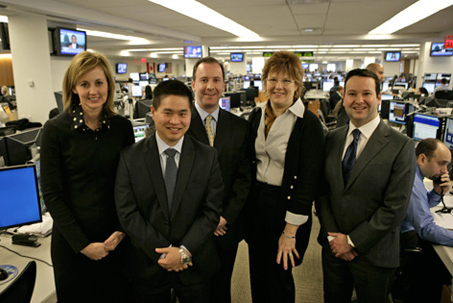By David Li, bostonese.com
Boston, March 30, 2013, — You may have heard of high-frequency traders of Wall Street. But you may not know that how they are making billions of dollars at your expense. The new book Flash Boys by best-selling author Michael Lewis takes a close look of computerized high-frequency trading through the eyes of a former trader Brad Katsuyama.

Brad Katsuyama(second from left) and his RBC team in 2010.
During CBS’ 60-minutes program on March 30, 2014, author Michael Lewis talked about his new book Flash Boys, which tells the story of how former trader Brad Katsuyama of Royal Bank of Canada (RBC) helped uncover the secret of high-frequency traders. The speed advantage in fractions of milliseconds of the high-frequency traders allows the so call front-running trading, which puts average institutional and individual investors at disadvantage. In other words, high-frequency traders found a way to rig the US stock market legally.
Katsuyama recalled on camera during the 60-minutes interview that he was never able to get the large buying order of stocks at the price he wanted. Katsuyama explains that when part of his buying order is executed, the computer programs of high-frequency traders saw the order from the exchanges, and also buys the same stock, and thus drive up the price of the stock. The computer program then could sell the stocks at one or two penny’s profit a millisecond or two later.
By studying the locations of public exchanges in New York and New Jersey, Katsuyama realized that how the high-frequency traders took advantage of the system to put profits in their own pocket. Computerized high-frequency trading now makes up about 50% all US stock trading, and provides a steady income stream for stock exchanges.
Katsuyama decided to quit his high-paying job at RBC, and started a new stock trading platform: International Exchange (IEX). He wanted to address this problem by providing a more balanced marketplace via simplified market structure design to discourage predatory trading.

IEX’ trading platform was launched on Oct. 2013, and is the first equity trading venue owned exclusively by a consortium of buy-side investors. Katsuyama smirked during the interview and said: “IEX’s selling point is the trustworthiness.” To average American people, they wonder if that’s something Wall Street still possesses.